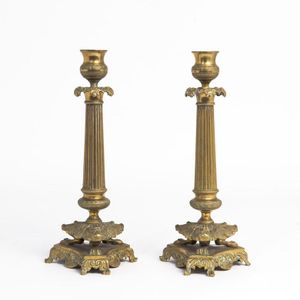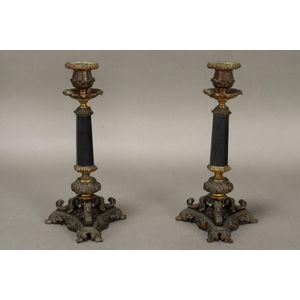19th Century Bronze and Onyx Candlesticks
Pair of 19th century bronze and black onyx candlesticks, with flower bud sconces above facetted black onyx supports on scrolling rococo bases, height 27 cm (2)
You must be a subscriber, and be logged in to view price and dealer details.
Subscribe Now to view actual auction price for this item
When you subscribe, you have the option of setting the currency in which to display prices to $Au, $US, $NZ or Stg.
This item has been sold, and the description, image and price are for reference purposes only.
- Bronze - An alloy of copper and tin, traditionally in the proportions of about 9 parts of copper to 1 part of tin.
The discovery of bronze in Western Asia in the 4th century enabled people to create metal objects which were superior to those previoulsy possible because of its strength and hardness, and it has been used throughout the world for weapons, coins, tools, statuary and other decorative items.
It is very fluid in a molten state, and its hardness, strength when set, and non-corrosive properties makes it most suitable for casting sculpture. - Onyx - Onyx is a form of agate, used from antiquity and popular again in the 1920s and 30s. European onyx is generally green, but can be many other colours, and can contain bands of black and/or white.
This multicoloured stone is widely used for table tops, lamp bases and in jewellery. Some types of onyx are also used for cameos of which the upper white layer is cut away to reveal the colour beneath. - Sconce - A light attached to a wall. Originally a candle holder that is attached to a wall with an ornamental bracket and sometimes with a reflective back plate, but now applied to an electric light that has been inspired by that design.
In recent times the word has also come into use to desribe the candle holders on a candelabra. - Faceting - Faceting is a technique of removing material from a curved surface, to give a series of flat surfaces but retaining the profile of the original surface.
The technique is most commonly associated with diamond cutting where the various cuts used such as rose cut and brilliant cut, add life and sparkle to the stone, whilst at the same time removing as little of the stone as possible.
Faceting by grinding is also used to decorate glass. The stems of many drinking glasses are decorated by cutting a series of flat surfaces on a circular stem, and hollow vessels such as vases may have faceted surfaces.
In furniture faceting is often applied to legs of tables and chairs, where a circular baluster shaped section is flattened so as to form an octagonal section.
This item has been included into following indexes:
-
candlesticks, material
- gilt and bronze 259
- ormolu and bronze 181
Visually similar items

Tall pair of Antique French carved walnut prickets, carved turned fluted supports, tri form bases 115 cm high (2)
Sold by
in
for
You can display prices in $Au, $US, $NZ or Stg.

A pair of brass candlesticks on tripod base, French, 19th century, 28 cm high
Sold by
in
for
You can display prices in $Au, $US, $NZ or Stg.

Pair of antique French candlesticks, each approx 24 cm high (2)
Sold by
in
for
You can display prices in $Au, $US, $NZ or Stg.

Pair of antique French bronze candlesticks, each approx 21 cm high (2)
Sold by
in
for
You can display prices in $Au, $US, $NZ or Stg.
